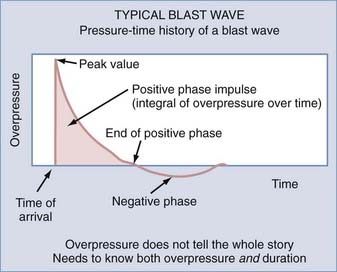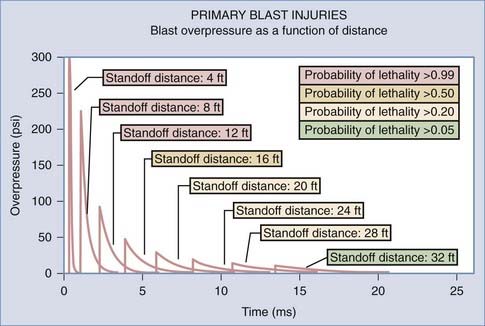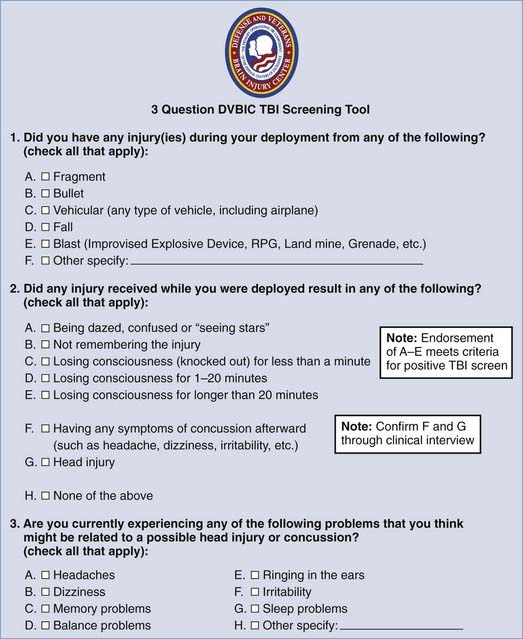CHAPTER 337 Blast-Induced Neurotrauma
Blast Injury is a Frequent Cause of Traumatic Brain Injury in the Modern Combat Theater
Blast injury is a common mechanism of traumatic brain injury (TBI) among soldiers serving in Iraq and Afghanistan. One study found that approximately two thirds of war zone casualties evacuated to Walter Reed Army Medical Center had injuries attributable to blast mechanisms.1 Another study found that 88% of military personnel treated at an echelon II medical unit in Iraq had been injured by improvised explosive devices (IEDs) or mortars, 47% of which involved head injuries.2 A third study reported that 97% of the injuries to marines in one unit in Iraq were due to explosions (65% IEDs, 32% mines). The majority of them (53%) involved the head or neck.3 Finally, between July and November 2003, the Defense and Veterans Brain Injury Center (DVBIC) screened 155 patients who had returned from Iraq and were deemed as being at risk for brain injury. Of the 88 victims of blast injuries included in the total number screened, 61% were identified as having sustained a brain injury.4 The DVBIC screening tool that has been used to screen soldiers returning from deployment for TBI is listed in Figure 337-1. Although penetrating TBI is typically identified and treated immediately, mild TBI may be missed, particularly in the presence of other more obvious injuries. Currently, however, the diagnosis of a blast concussive injury is based primarily on the characteristics of the injury event and not by the severity of symptoms after the trauma.
Blast Injury May Induce Changes in the Brain Not Seen With Non–Blast-Related Mechanisms
Blast-induced neurotrauma is the term given to describe an injury to the brain that occurs after exposure to a blast.5 Blast injury can be classified into five types:
* Blast injuries can be classified into one of five predominant treatment classes based on the acute events after the blast. Frequently, these injuries are characterized by more than one type of blast injury.
The blast is produced by a transient pressure wave in air or water after denotation of an explosive device. Rapidly expanding gas transfers mechanical, thermal, and electromagnetic energy into the surrounding medium. A typical blast wave is depicted in Figure 337-2. The amount of force exerted on the victim is not only determined by the peak value of the overpressure but is also a function of duration. Survival in the vicinity of a blast explosion is a function of the peak overpressure and range (Figure 337-3). Explosions in a contained space can increase the force of the blast waves as they are reflected off the walls. This creates a complex wave field in which overpressure waves can be additive.

FIGURE 337-2 Typical blast wave that encompasses both overpressure and underpressure over a given duration.
(Courtesy of Colonel John B. Holcomb, U.S. Army Institute of Surgical Research.)

FIGURE 337-3 The magnitude of the primary blast injury inversely correlates with the distance from the blast.
(Courtesy of Colonel John B. Holcomb, U.S. Army Institute of Surgical Research.)
The precise mechanism of primary blast-induced neurotrauma remains unknown. Combat body armor provides soldiers with considerable protection against penetrating ballistic injury, yet it is unlikely to afford significant protection from the effects of blast overpressure. Clinical experience in the combat theater has shown that blast lung injury is less frequent than blast-induced neurotrauma. This is somewhat surprising because the lung is an air-filled organ and was therefore historically thought to be more susceptible to blast injury.6 The bowel, another air-filled organ, is also rarely injured after exposure to blast trauma. Therefore, the brain represents an organ that is uniquely vulnerable to blast-induced injury. The mechanism of blast-induced neurotrauma remains an area of active research.
Animal models are currently being developed to better understand the pathophysiology of blast injury.7,8 Gene expression profiling of animal models of blast injury to the brain shows that proteins involved in regulation of the cell cycle are differentially expressed after TBI.9 Astrocytes and neurons may enter the cell cycle again after TBI; scar formation is due to proliferating astrocytes, whereas neurons die on re-entering the cell cycle because of caspase-mediated apoptosis.10 The cell cycle inhibitor flavopiridol was found to decrease scar formation and promote cognitive recovery after fluid percussion injury in rats.11 Although blast-induced neurotrauma shares many similarities with axonal damage sustained by non–blast-involved mechanisms, there are also important differences.12 Blast-induced neurotrauma may be more likely to result in axonal swelling and edema and less likely to produce hemorrhage. The frequency of hemorrhage detected on head computed tomography (CT) among all civilian mild TBI cohorts typically ranges from 3% to 10%. Ongoing studies of mild TBI in Iraq and Afghanistan suggest that the percentage of positive CT scans is even lower than in the civilian setting (G. Grant, personal communication). This underscores the unique pathophysiology of blast injury to the brain.
primary Blast injury Biomarkers
Because the symptoms of primary blast injury are often not manifested until some time after the injury has occurred and the findings on imaging are usually normal, there has been a search for an objective test to verify the presence of primary blast-induced neurotrauma in the acute setting, such as a biomarker or neurocognitive screen.13 S100β has been the biomarker studied best in the setting of civilian TBI. One study showed that S100β levels correlate with the Marshall and colleagues’ CT classification of the severity of TBI.14,15 Other studies have likewise shown a relationship between the severity of head injury and levels of S100β.16–18 However, S100β was also found to be a poor predictor of outcome in mild TBI19 and has been shown to increase even in patients with long-bone fractures and no head injury. Its expression is not limited to the central nervous system (CNS); it is also expressed in the Schwann cells of peripheral nerves. Therefore, the usefulness of S100β as a biomarker to determine the outcome of blast-induced neurotrauma remains questionable, especially in the military setting, where polytrauma is much more common. Glial fibrillary acidic protein (GFAP) is expressed only in the CNS and therefore has recently received attention as a possible biomarker. Indeed, GFAP was found to be a predictor of mortality in TBI.18,20 Thus, the clinical applicability of GFAP to determine the outcome of primary blast-induced neurotrauma remains to be determined. Neuron-specific enolase is not used anymore as an acute biomarker of brain injury because of its expression in non-neuronal tissue, such as red blood cells and platelets, and its long half-life of 20 hours.21 A number of other proteins are currently under investigation as suitable biomarkers for TBI, such as cleaved-tau (c-tau), αII-spectrin breakdown products, N-methyl-D








